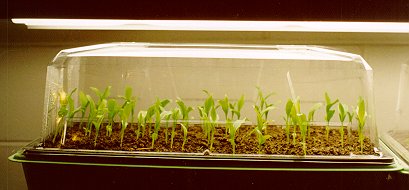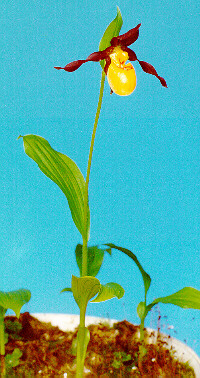
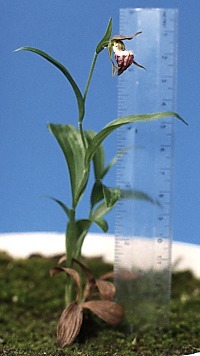
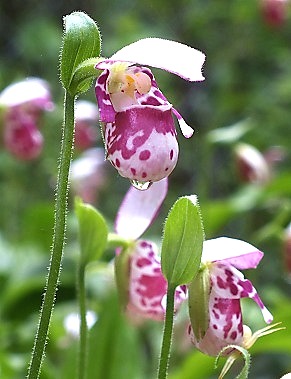 Whether you can grow our seedlings depends greatly on where you live. Cyps
are temperate orchids and have adapted to temperate climates by
becoming dormant during times of inhospitably cold weather. Most species
require several months at near-freezing temperature during dormancy to
become "vernalized," i.e., brought to the condition they are normally
in at springtime, so that they can produce leaves. If your climate does
not offer several months of temperatures near- or below-freezing, your
plants probably will not leaf-out normally unless given artificial refrigeration
during the winter.
Whether you can grow our seedlings depends greatly on where you live. Cyps
are temperate orchids and have adapted to temperate climates by
becoming dormant during times of inhospitably cold weather. Most species
require several months at near-freezing temperature during dormancy to
become "vernalized," i.e., brought to the condition they are normally
in at springtime, so that they can produce leaves. If your climate does
not offer several months of temperatures near- or below-freezing, your
plants probably will not leaf-out normally unless given artificial refrigeration
during the winter.
As an example of the problems of growing a species outside its native range, consider C. guttatum, shown at right, which is a native of Alaska. While the plant thrives here in Minnesota, it would not be expected to survive in the southern U.S. Growing the plant is difficult even in northern states such as New York and Washington although this species has been grown successfully as far south as Iowa. The difficulty is that C. guttatum demands a cool root zone, and maintaining low soil temperatures in climates where both days and nights are warm is problematical.
If you plan to grow your plants outdoors, choose only those from areas similar to yours climatically. Growers in northern areas should choose species from northern climates, as plants native to warmer areas may not survive freezing of the ground. People in the south should only attempt southern species as northern species may not vernalize properly. Species from humid climates may die of desiccation in areas with low summertime relative humidity. Species from dry areas may die of too much moisture in rainy climates. If seedlings are selected from climates different from your own, the plantlets will probably require some combination of greenhouse care, artificial refrigeration, and protection from excessive rainfall. Protection from pests is also essential. Even in ideal climates, the protection of a greenhouse allows the horticulturist to keep better watch on specimens and to provide better control over the environment of the plants.


Two examples of early-blooming specimens. The C. parviflorum
var. parviflorum at left bloomed the third season, i.e., two years,
after potting. The C. arietinum at right flowered the very next
year after potting! Such precocious development should be treated as a
pleasant surprise, not an expectation.
The seedlings may either be planted in an inorganic material such as perlite and fed with very dilute fertilizer solutions during the growing season or planted in a soil mix to which perlite, sand, or other material has been added to lighten the medium and promote drainage. The details of the mix, the amount of water, the intensity of lighting, and the temperature requirements vary considerably from one species to another. We supply detailed growing instructions with all our seedlings. The following photo sequence shows C. reginae seedlings planted in a square pot and their subsequent development:
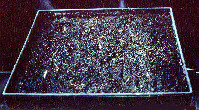 The photo at left shows five C. reginae seedlings planted at the
proper depth with the tips of the shoot buds barely protruding above the
soil. The pot is approximately 16 cm (6.3 in) on an edge.
The photo at left shows five C. reginae seedlings planted at the
proper depth with the tips of the shoot buds barely protruding above the
soil. The pot is approximately 16 cm (6.3 in) on an edge.
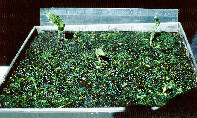 One month later, the same five seedlings have produced leaves. The plastic
scale is 15 cm (6.0 in) long.
One month later, the same five seedlings have produced leaves. The plastic
scale is 15 cm (6.0 in) long.
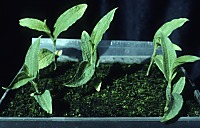 Two months after the first photo was taken, these five seedlings have the
maximum leaf development for the season. All additional growth this season
will occur in the roots.
Two months after the first photo was taken, these five seedlings have the
maximum leaf development for the season. All additional growth this season
will occur in the roots.
Because our seedlings are small, they require great vigilance by the grower. Our young plantlets are barely a meal for many an invertebrate pest! Some growers have built small hardware cloth cages around their plants or put plastic berry boxes over the seedlings for protection from predators. The moisture content of the soil is critical. If the soil is too wet, the plants die from lack of oxygen or from disease, but because the roots are so short, the seedlings may die quickly if the upper few centimeters of the soil become dry. The grower must check plants daily or even more often during periods of unusually hot, dry, or wet weather.
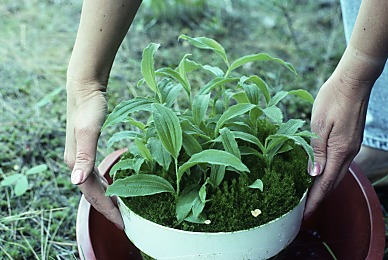
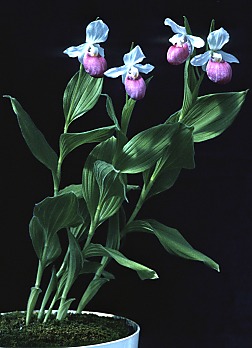
Cypripedium seedlings can be grown indoors under artificial lights. The photo below shows a flat of C. reginae seedlings under a six-inch high plastic dome being illuminated by two wide spectrum 40-watt fluorescent grow light tubes. Such lights are barely bright enough, and much better results can be obtained using metal halide lights. LED grow lights show much promise.
